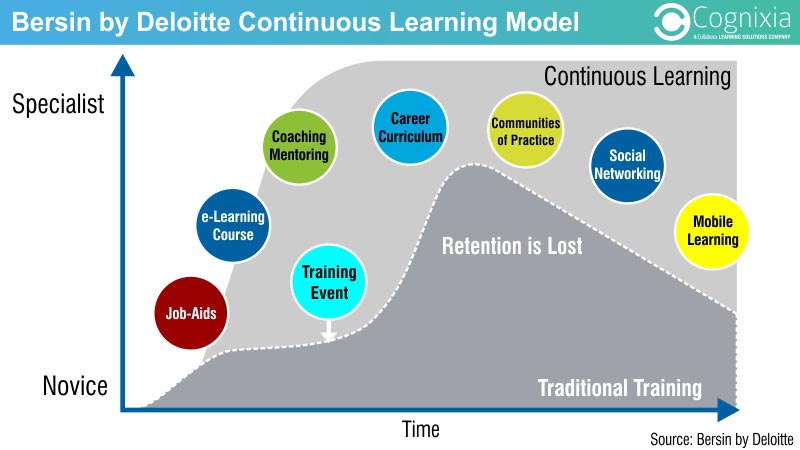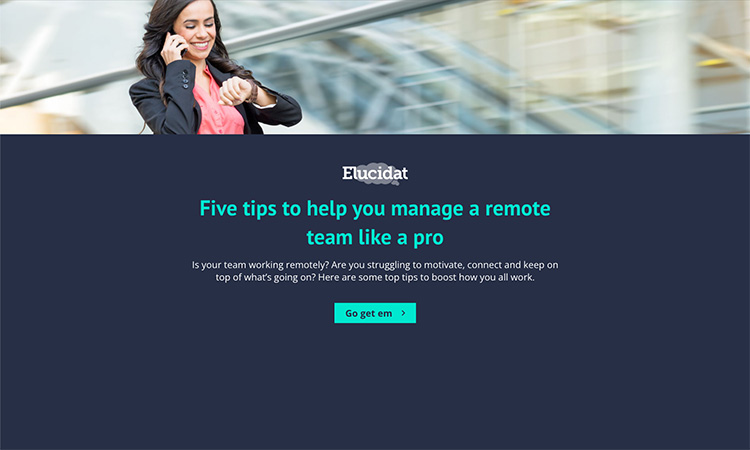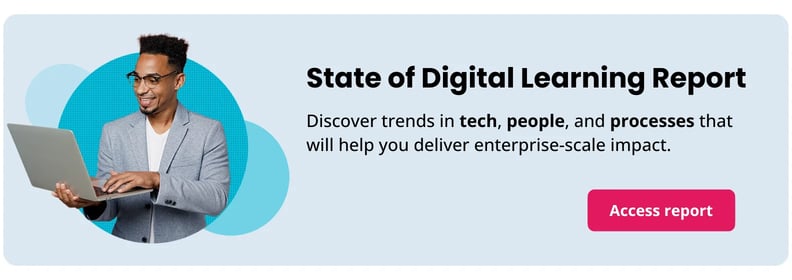What is continuous learning and why should you care?
7 minute read
Staying competitive in today’s ever-changing global marketplace requires innovation and adaptation. If your employees are going to have the skills required for success, their learning and development needs to be an ongoing process. You can achieve this by embracing continuous learning – the ongoing expansion of knowledge and skill sets. Find out how by exploring our strategies for continuous learning.

What is continuous learning?
Continuous learning is the ongoing process of acquiring new knowledge and skills, as well as reinforcing what you’ve previously learned.
The definition of continuous learning is broad. It takes in professional and personal development, formal and informal learning, and structured or unstructured training. From studying for a qualification to chatting with a more experienced colleague, it can involve all kinds of learning methods.
The key thing is that learning isn’t a finite process. Learning doesn’t just happen to check a box. Rather than one-off training courses that focus on a single objective, continuous learning is the goal in itself. The lifelong learning skills that are developed are invaluable to both the organization and the individual.
Why is continuous learning important?
In an ever-shifting social and economic landscape, a business’ success depends on its people’s ability to adapt. Hiring new people to fill each emerging skill gap is not sustainable. So, employee skill sets need to evolve to meet current and longer-term business demands.
Whether it’s a new process or piece of tech, successfully responding to change requires people to learn and develop. Without a continual process of learning, changes aren’t adopted and innovation doesn’t happen. Ultimately, businesses and employees lose out.
If organizations and individuals want to stay competitive in an ever-changing marketplace, they need to develop the skills needed to learn and innovate. But this won’t just happen on its own. While one-off training interventions can have an impact, this depreciates over time. Continuous learning allows an organization to reach and maintain higher levels of employee knowledge and skills through consistent reinforcement.
Here is an example from Deloitte of what a continuous learning model could look like:

By supporting learning in everything an organization does, ongoing development becomes part of the culture. Employees don’t just complete training. They develop a growth mindset and continuously seek, share, and apply their new knowledge and skills.
What are the benefits of continuous learning?
Embedding continuous learning practices in the work environment benefits everyone.
Employees benefit from continued learning through:
- Improved job satisfaction: Doing the same thing over and over is repetitive. Learning new skills staves off boredom and keeps employee interest levels high.
- Clear career progression: Developing new skills and knowledge can increase competence and personal performance, which helps employees achieve their career goals. This can also influence future opportunities within the organization, such as promotions and financial incentives.
- Increased engagement: Support of continuous learning demonstrates businesses are genuine about employee career development. This investment makes employees feel valued and more engaged with their work and employer.
- Maintained professional skill set: Whether it’s professional licenses or the latest trends, staying up to date with industry advances can help employees stay marketable.
- Personal development: Continuous learning at work doesn’t just lead to career development and professional certifications. It develops the lifelong learning skills that lead to greater personal fulfilment and enjoyment.
Organizations with a culture of continuous learning see:
- Improved responsiveness and adaptability: Continuously developing the ability to learn; leads to an enhanced capacity to adapt to changing business needs and a capacity to acquire new skills.
- Increased innovation: If your people are comfortable exploring new learning, skills and ideas, they’ll approach challenges with a positive mindset and come up with more innovative and effective solutions.
- Greater employee retention: Investing in employee development and having a culture of continuous learning is one of the biggest incentives for people to stay in their employment. In fact, 94% of employees say they would stay in a company if they invested in their learning and development.
- Reduced costs: It’s far less expensive to invest in the continuous development of current employees than to hire and train a new employee. While the exact cost of high employee turnover varies, the average cost of losing an employee is in the thousands. Some estimate that every time a business replaces an employee, it costs 6 to 9 months’ salary.
- Improved performance: With the right knowledge and skills, employees can contribute more to the organizational goals. Ultimately, this increased efficiency and productivity leads to the success of your business.
Three continuous learning strategies
Even with all these benefits, employees might not see constant learning and development as a priority. With lots of other demands on their time, how can you make learning part of people’s everyday work?
Here are three key strategies to create a supportive learning environment:
- Make it strategic: If you’re going to embed a culture of continuous learning, it needs to be part of the day-to-day way the business runs. This starts with the business goals and strategy, which filters down through policy and process to individual learning and development plans.
- Lead by example: A culture starts at the top. It’s vital that management not only communicate their full support for continuous learning activities, but demonstrate it. That means being a role model – displaying a growth mindset, trying things out and learning from mistakes. It involves encouraging colleagues to reflect on their work and share their learning.
- Provide time and resources: Faced with daily tasks and urgent deadlines, it can be difficult for employees to take time to learn. If you’re going to create a supportive environment where continuous learning is possible, time and resources need to be made available to all employees.
Want to find other approaches to develop a continuous learning environment in your organization? Explore our 5 ways to create a learning culture.
Continuous learning examples
Once it’s embedded in an organization, continuous learning is omnipresent. It will occur in every interaction, and in all kinds of contexts.
Every organization, team and employee is different. So, there isn’t one right way to develop a continuous learning culture. Instead, you can and should support a variety of learning approaches.
Here are just some examples of the range of continuous learning activities to get you inspired.
Formal learning
Formal learning is preorganized for specific goals and purposes. It can include professional qualifications and mandated training courses. Providing access to professional development via memberships is a good example of an ongoing formal learning resource used in continuous training.
Self-directed learning
This is learning that employees undertake independently to expand skills and knowledge. It can include researching a topic or listening to relevant podcasts.
By providing easy access to clearly structured online learning, you can encourage effective self-paced learning. This team management elearning example uses microlearning for performance improvement. It lets learners explore five key tips at their own pace and provides an action plan to continue their learning in their work.

Mobile learning
People are used to having information at their fingertips. So, why should professional learning be any different? Mobile-friendly digital learning can be completed wherever, whenever and on any device. This means employees can access the information and skill support at the point of need.
Find out more about how to get the best results on mobile devices in our mobile learning design strategies blog.
Social learning
Social learning occurs when an employee interacts and collaborates with others to increase knowledge or learn new skills. Of course, this happens constantly in everyday work interactions. However, by recognizing and encouraging this kind of learning, employees begin to share what they’ve learned more widely.
This can include discussion on social media, team collaborations, line manager catch-ups, on-the-job coaching and holding Lunch & Learns.
This compliance elearning example uses social learning to instigate behavior change. Learners are asked to judge real situations and use social polls to compare their views with their colleagues.

Want to find out more about the learning approaches other organizations use. Listen to our Learning at Large podcasts to explore continuous learning at Cognizant and lifelong Learning at Smart & Final.
Summary
An effective culture of continuous learning is the key to staying competitive in a business landscape of constant change. From improved employee engagement and career progression to reduced costs and better business results, continuous learning offers many benefits.
Embedding a continuous learning culture can take many different approaches but it always starts from the top. Learning needs to be part of the business strategy. Leaders need to role model a growth mindset.
Whether it’s social learning or self-directed learning, time and resources should always be available to employees so they can learn in the way that’s best for them. Support and encourage learning in every interaction, and in all kinds of work contexts.
It could be professional or personal development, formal or informal learning, and structured or unstructured training. The critical thing is that it’s an ongoing process that drives innovation and success in your organization.
Interested to learn more?
Discover more about what your employees want and need to continue their learning in our Training Trends Report.




